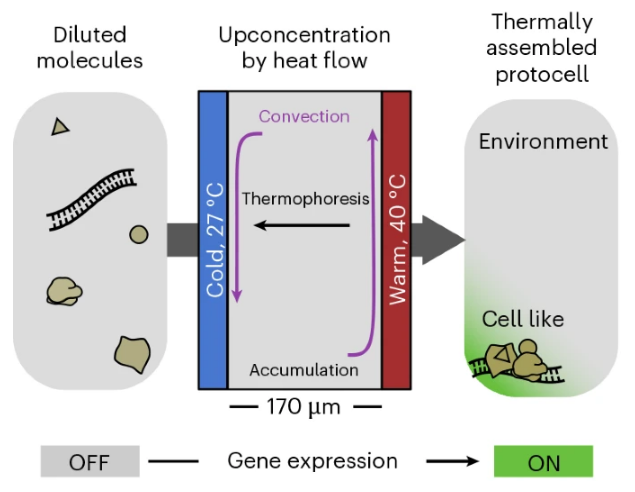
德国慕尼黑路德维希·马克西米利安大学Braun, Dieter团队揭示了受热流限制的无膜原始细胞。该研究于2025年6月26日发表在《自然—物理学》杂志上。
在活细胞中,生物分子的复杂混合物在膜内和膜间组装。这种非平衡状态是由复杂的蛋白质机制维持的,该机制输入食物分子,清除废物并协调细胞分裂。然而,目前尚不清楚这种复杂的细胞机制是如何出现和进化的。
研究组展示了细胞的分子含量如何以协调的方式与非平衡热流耦合。充满水的孔隙中的温差组装了现代细胞的核心成分,然后可以激活基因表达。该机制源于同一热源驱动的对流和热泳的相互作用。通过RNA从DNA合成蛋白质的细胞机制是细胞成分浓度的直接结果。
同样的非平衡设置继续从相邻的流体流中吸引食物分子,使细胞分子保持在一个封闭的口袋里,防止扩散。该研究结果表明,一个简单的非平衡物理过程可以组装细胞的许多不同分子并触发其基本功能。该框架提供了一个无膜环境,将从RNA世界到基于蛋白质的细胞样原代谢的漫长进化时间连接起来。
附:英文原文
Title: Membraneless protocell confined by a heat flow
Author: Floroni, Alexander, Yeh Martn, Nol, Matreux, Thomas, Weise, Laura I., Mansy, Sheref S., Mutschler, Hannes, Mast, Christof B., Braun, Dieter
Issue&Volume: 2025-06-26
Abstract: In living cells, a complex mixture of biomolecules is assembled within and across membranes. This non-equilibrium state is maintained by sophisticated protein machinery, which imports food molecules, removes waste products and orchestrates cell division. However, it remains unclear how this complex cellular machinery emerged and evolved. Here we show how the molecular contents of a cell can be coupled in a coordinated way to non-equilibrium heat flow. A temperature difference across a water-filled pore assembled the core components of a modern cell, which could then activate the gene expression. The mechanism arose from the interplay of convection and thermophoresis, both driven by the same heat source. The cellular machinery of protein synthesis from DNA via RNA was triggered as a direct result of the concentration of cell components. The same non-equilibrium setting continued to attract food molecules from an adjacent fluid stream, keeping the cellular molecules in a confined pocket protected against diffusion. Our results show how a simple non-equilibrium physical process can assemble the many different molecules of a cell and trigger its basic functions. The framework provides a membrane-free environment to bridge the long evolutionary times from an RNA world to a protein-based cell-like proto-metabolism.
DOI: 10.1038/s41567-025-02935-4
Source: https://www.nature.com/articles/s41567-025-02935-4
